→ → Go back HOME to Zamboanga: the Portal to the Philippines.
|
|
| (3 intermediate revisions by the same user not shown) |
| Line 6: |
Line 6: |
| ---- | | ---- |
| |- | | |- |
| |valign=top|'''Avocado''': | | |valign=top|'''Avocado''': The avocado fruits while still on the tree. |
| |valign=top|[[File:Avocado.jpg|150px]] | | |valign=top|[[File:Avocado.jpg|150px]] |
| |- | | |- |
| Line 14: |
Line 14: |
| |valign=top|'''Balimbing, starfruit, carambola''': The many sided fruit. Also referred to two-faced politicians. The fruit itself is tastes tart, sour and sweet at the same time. | | |valign=top|'''Balimbing, starfruit, carambola''': The many sided fruit. Also referred to two-faced politicians. The fruit itself is tastes tart, sour and sweet at the same time. |
| |valign=top|[[File:Balimbing, starfruit, carambola.jpg|150px]] | | |valign=top|[[File:Balimbing, starfruit, carambola.jpg|150px]] |
| | |- |
| | |colspan=2| |
| | ---- |
| | |- |
| | |valign=top|'''Banana''': The red Banana (Banegas). Family of the greenish banana (bungulan) |
| | |valign=top|[[File:Banana banegas.jpg|150px]] |
| |- | | |- |
| |colspan=2| | | |colspan=2| |
| Line 65: |
Line 71: |
| |valign=top|[[Image:Strawberry1.jpg|150px]] | | |valign=top|[[Image:Strawberry1.jpg|150px]] |
| |} | | |} |
| ----
| |
| <Gallery>
| |
| File:Makupa.jpg|makupa
| |
| File:Lanzones.jpg|Lanzones
| |
| File:Lanzones 1.jpg|Lanzones
| |
| </Gallery>
| |
Latest revision as of 17:30, 7 April 2017
Different types of Fruits
|
| Avocado: The avocado fruits while still on the tree.
|
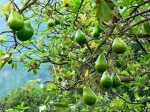
|
|
| Balimbing, starfruit, carambola: The many sided fruit. Also referred to two-faced politicians. The fruit itself is tastes tart, sour and sweet at the same time.
|
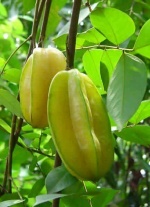
|
|
| Banana: The red Banana (Banegas). Family of the greenish banana (bungulan)
|
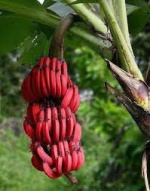
|
|
| Durian: The large "durian" tree bears these aromatic fruits that are popular in Davao City. The round to oblong fruit has green to brown rind covered with hard spines. When ripe, it has a thick, firm and creamy pulp that covers brown seeds. It is made into sweets or eaten as is. The scent is overpowering which makes it one of the most unique fruits in the country.
|
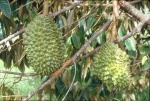
|
|
| Lemon: The lemon is the common name for Citrus limon. The reproductive tissue surrounds the seed of the angiosperm lemon tree. The lemon is used for culinary and nonculinary purposes throughout the world. The fruit is used primarily for its juice, though the pulp and rind (zest) are also used, primarily in cooking and baking. Lemon juice is about 5% (approximately 0.3 mole per liter) citric acid, which gives lemons a tart taste, and a pH of 2 to 3. This makes lemon juice an inexpensive, readily available acid for use in educational science experiments. Because of the tart flavor, many lemon-flavored drinks and candies are available on the market, including lemonade.
The exact origin of the lemon has remained a mystery, though it is widely presumed that lemons first grew in India, northern Burma, and China.In South and South East Asia, it was known for its antiseptic properties and it was used as an antidote for various poisons. It was later introduced to Persia and then to Iraq and Egypt around AD 700. The lemon was first recorded in literature in a tenth century Arabic treatise on farming, and was also used as an ornamental plant in early Islamic gardens. It was distributed widely throughout the Arab world and the Mediterranean region between AD 1000 and AD 1150.
|

|
|
| Papaya: Green Papaya
|
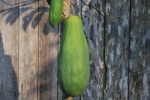
|
|
| Pineapple: Pineapple (Ananas comosus) is the common name for a tropical plant and its edible fruit which are coalesced berries. Pineapples are the only bromeliad fruit in widespread cultivation. It can be grown as an ornamental, especially from the leafy tops. Some sources say that the plant will flower after about 24 months & produce a fruit during the following six months while others indicate a 20-month timetable.
Pineapple is eaten fresh or canned or juiced. It is popularly used in desserts, salads, as a complement to meat dishes and in fruit cocktail. The popularity of the pineapple is due to its sweet-sour taste containing 15% sugar and malic and citric fruit acids. It is also high in vitamin B1, B2, B6 and C. Its protein-digesting enzyme bromelain seems to help digestion at the end of a high protein meal.
In the Philippines, pineapple leaves are used as the source of a textile fiber called piña.
- source:Wikipedia
|
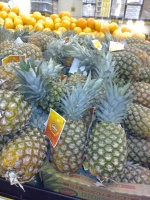
|
|
| Siniguelas: The siniguelas, also known as Spanish plum, resembles a large grape and is available during the summer. The skin is either yellow or purple when ripe and green when unripe. Its juicy yellow flesh encloses a seed as large as the fruit.
|
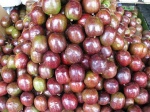
|
|
| Strawberry: Delicious red strawberries. The garden strawberry, Fragaria × ananassa, is a hybrid species that is cultivated worldwide for its aggregate accessory fruit, the (common) strawberry. The fruit is widely appreciated, mainly for its characteristic aroma but also for its bright red color, and it is consumed in large quantities, either fresh or in prepared foods such as preserves, fruit juice, pies, ice creams, and milk shakes. Artificial strawberry aroma is also widely used in all sorts of industrialized food products.
The garden strawberry was first bred in Brittany, France, about 1740 via a cross of Fragaria virginiana from eastern North America , which was noted for its flavor, and Fragaria chiloensis from Chile and Argentina brought by Amédée-François Frézier, which was noted for its large size.
Cultivars of Fragaria × ananassa have replaced, in commercial production, the woodland strawberry, which was the first strawberry species cultivated in the early 17th century.
The strawberry is, in technical terms, an aggregate accessory fruit, meaning that the fleshy part is derived not from the plant's ovaries (achenes) but from the receptacle that holds the ovaries. Each "seed" on the outside of the fruit is actually one of the ovaries of the flower, with a seed inside it. In both culinary and botanical terms, the entire thing is called a "fruit".
- information source:wikipedia
|
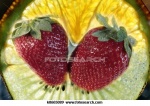
|








